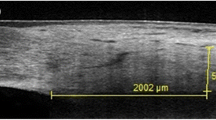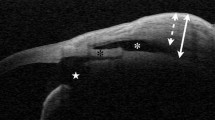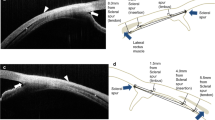Abstract
Purpose
To determine the differences in scleral shape between the superonasal and superotemporal quadrants, the sites of scleral flap creation in trabeculectomy, using anterior segment optical coherence tomography (OCT).
Methods
Thirty-four right eyes of 34 enrolled subjects without ocular disease, with the exception of cataract or ametropia, were studied. Mean patient age was 63.2 ± 15.9 (standard deviation) years (range 28–84 years). The same examiner captured all images using anterior segment swept source OCT. The mean measurements were calculated from three images captured for each eye, 60° from the horizontal line passing through the pupillary center in the superonasal and superotemporal sclera. The radius of the scleral surface curvature and the area of the convex part of the sclera between the superonasal and the superotemporal quadrants were determined using image analysis software and the paired t test.
Results
The radius of the scleral curvature was significantly different in the superonasal quadrant and superotemporal quadrant (34.3 ± 12.6 vs. 18.3 ± 3.6 mm, respectively; P < 0.001). The area of the convex part of the sclera was also significantly different in the superonasal and superotemporal quadrants (0.36 ± 0.1 vs. 0.57 ± 0.1 mm2, respectively; P < 0.001).
Conclusions
Anterior segment OCT analysis of the scleral shape revealed a more gradual scleral gradient in the superonasal quadrant compared with the superotemporal quadrant.






Similar content being viewed by others
References
Soltau JB, Rothman RF, Budenz DL, Greenfield DS, Feuer W, Liebmann JM, et al. Risk factors for glaucoma filtering bleb infections. Arch Ophthalmol. 2000;118:338–42.
Higginbotham EJ, Stevens RK, Musch DC, Karp KO, Lichter PR, Bergstrom TJ et al. Bleb-related endophthalmitis after trabeculectomy with mitomycin C. Ophthalmology. 1996;103:650–6.
Edmunds B, Bunce CV, Thompson JR, Salmon JF, Wormald RP. Factors associated with success in first-time trabeculectomy for patients at low risk of failure with chronic open-angle glaucoma. Ophthalmology. 2004;111:97–103.
Negi AK, Kiel AW, Vemon SA. Does the site of filtration influence the medium to long term intraocular pressure control following microtrabeculectomy in low risk eyes? Br J Ophthalmol. 2004;88:1008–11.
Sanders R, MacEwen CJ, Haining WM. Trabeculectomy: effect of varying surgical site. Eye (Lond). 1993;7:440–3.
Park HY, Ahn MD. Imaging of trabeculectomy blebs with Visante anterior segment optical coherence tomography after digital ocular compression. Jpn J Ophthalmol. 2012;56:38–45.
Kim SH, Park KH. Anterior segment optical coherence tomography (AS-OCT) cannot be a substitution of gonioscopy. Jpn J Ophthalmol. 2013;57(5):493–4.
Yun S, Tearney G, de Boer J, Iftimia N, Bouma B. High-speed optical frequency-domain imaging. Opt Express. 2003;11:2953–63.
Yasuno Y, Madjarova VD, Makita S, Akiba M, Morosawa A, Chong C, et al. Three-dimensional and high-speed swept-source optical coherence tomography for in vivo investigation of human anterior eye segments. Opt Express. 2005;13:10652–64.
Bartko JJ, Carpenter WT Jr. On the methods and theory of reliability. J Nerv Ment Dis. 1976;163:307–17.
McGraw KO, Wong SP. Forming inferences about some intraclass correlation coefficients. Psychol Method. 1996;1:30–46.
Asejczyk-Widlicka M, Schachar RA, Pierscionek BK. Optical coherence tomography measurements of the fresh porcine eye and response of the outer coats of the eye to volume increase. J Biomed Opt. 2008;13:024002.
Michaels RG, Wilkinson CP, Rice TA, Hengst TC, editors. Retinal detachment. St. Louis: CV Mosby Company; 1990.
Ohno-Matsui K, Akiba M, Modegi T, Tomita M, Ishibashi T, Tokoro T, et al. Association between shape of sclera and myopic retinochoroidal lesions in patients with pathologic myopia. Invest Ophthalmol Vis Sci. 2012;53:6046–61.
Rauber A, Kopsch FR (eds). Rauber–Kopsch Lehrbuch und Atlas der Anatomie des Menschen. Band 1: Allgemeines, skeletsystem, muskelsystem. Leipzig: Georg Thieme Verlag; 1947. (In German).
Hogan MJ. The sclera. In: Hogan ML, Alvarado JA, Weddell JE, editors. Histology of the human eye: an atlas and textbook. Philadelphia: W. B. Saunders; 1971. p. 183–201.
Conflicts of interest
M. Kasahara, None; N. Shoji, None; T. Morita, None; K. Shimizu, None.
Author information
Authors and Affiliations
Corresponding author
About this article
Cite this article
Kasahara, M., Shoji, N., Morita, T. et al. Comparative optical coherence tomography study of differences in scleral shape between the superonasal and superotemporal quadrants. Jpn J Ophthalmol 58, 396–401 (2014). https://doi.org/10.1007/s10384-014-0329-1
Received:
Accepted:
Published:
Issue Date:
DOI: https://doi.org/10.1007/s10384-014-0329-1




